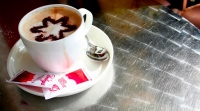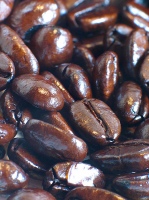The "Flat White," London's and New Zealand's Favorite Espresso Drink
The Flat White can best be understood by the American audience as a double short no-foam latte. It begins with two shots of espresso pulled ristretto - short - in order to maximize flavor while minimizing bitterness. There are three ways to pull a ristretto shot:
1. Grind the beans more finely, and pull a normal amount of water through them. Since the water has less contact with the finer grinds, it will extract less bitterness from them.




